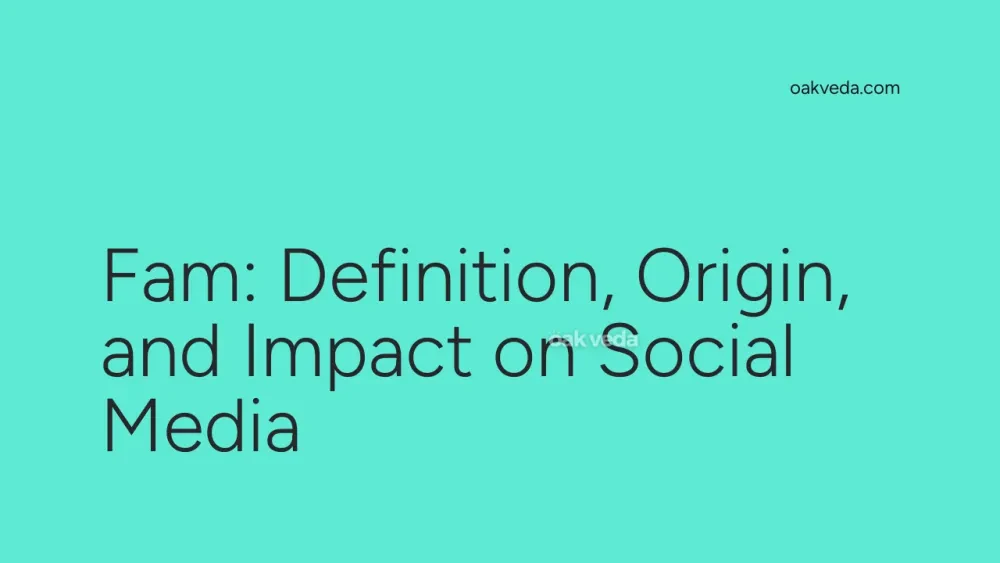
What is "Fam"?
"Fam" is a popular slang term used extensively on social media platforms and in everyday conversations. It's an abbreviated form of the word "family," but its meaning extends far beyond blood relations. In the context of social media, "fam" is used as a term of endearment to refer to close friends, loyal followers, or a tight-knit community of like-minded individuals.
Origin and Development of "Fam"
The origins of "fam" can be traced back to African American Vernacular English (AAVE). AAVE is a dialect of English primarily spoken by African Americans in the United States, characterized by its unique vocabulary, grammar, and pronunciation patterns.
In AAVE, "fam" emerged as a term of endearment and camaraderie within African American communities. It served as a way to express solidarity, support, and a sense of shared experiences. Over time, the term's usage expanded beyond its original context, gaining popularity in broader social circles and eventually making its way into mainstream social media vernacular.
How "Fam" Works in Social Media
On social media platforms, "fam" functions as a versatile term that can be used in various ways:
- Addressing followers: Influencers and content creators often use "fam" to address their audience, creating a sense of community.
- Expressing agreement: Users might respond with "Thanks, fam" or "You got it, fam" to show appreciation or agreement.
- Hashtags: The term is frequently used in hashtags like #FamGoals or #SquadFam to emphasize close relationships or group activities.
- Captions: "Fam" often appears in photo captions to describe gatherings with friends or to highlight a sense of belonging.
Popular Examples of "Fam" Usage
- "What's good, fam? Hope you're all having a great day!"
- "Shoutout to my YouTube fam for hitting 1 million subscribers!"
- "Just dropped a new track. Stream it now, fam!"
- "Who's coming to the meetup this weekend? Can't wait to see my Instagram fam IRL!"
Impact of "Fam" on Social Media Culture
The widespread adoption of "fam" on social media has had several notable impacts:
- Fostering inclusivity: By using "fam," content creators and brands can make their audience feel more included and valued.
- Breaking down barriers: The term helps create a sense of familiarity between strangers who share common interests online.
- Influencing marketing strategies: Brands have incorporated "fam" into their social media communications to appear more relatable and connect with younger audiences.
- Evolving language: The popularity of "fam" demonstrates how social media can accelerate the adoption and evolution of slang terms.
Controversies Surrounding "Fam"
While "fam" has become widely used across various communities, its adoption has not been without controversy:
- Cultural appropriation concerns: Some argue that the widespread use of "fam" by non-AAVE speakers constitutes cultural appropriation.
- Overuse and authenticity: Critics suggest that excessive use of "fam" by brands or influencers can come across as inauthentic or forced.
- Generational divide: Older generations may find the term confusing or inappropriate, leading to potential misunderstandings in cross-generational communication.
How Brands and Influencers Use "Fam"
Many brands and influencers have embraced "fam" as part of their social media strategy:
- Community building: Using "fam" helps create a sense of belonging among followers.
- Engagement boosting: The term is often used in calls-to-action to encourage likes, comments, and shares.
- Brand voice development: Incorporating "fam" into messaging can make a brand appear more youthful and relatable.
- Influencer partnerships: Brands may encourage influencers to use "fam" when promoting products to their followers.
Future Trends Related to "Fam"
As social media continues to evolve, so too will the usage of terms like "fam":
- Localization: We may see regional variations of "fam" emerge in different online communities.
- New platforms: As new social media platforms gain popularity, "fam" may adapt to fit their unique communication styles.
- Evolving meanings: The term's definition and usage may continue to shift as online culture develops.
- Potential decline: Like all slang terms, "fam" may eventually fall out of favor, replaced by newer expressions.
FAQs about "Fam"
-
Is it appropriate for everyone to use "fam"? While "fam" has become widely adopted, it's important to use it respectfully and be aware of its origins in AAVE.
-
Can "fam" be used in professional settings? Generally, "fam" is considered informal and is best reserved for casual social media interactions rather than professional communication.
-
Are there any alternatives to "fam"? Yes, similar terms include "squad," "crew," and "tribe," though these may have their own cultural connotations.
-
How can brands use "fam" authentically? Brands should use "fam" sparingly and naturally, ensuring it aligns with their overall voice and target audience.
-
Is "fam" used differently across various social media platforms? While the core meaning remains the same, usage may vary slightly depending on the platform's culture and demographic.
In conclusion, "fam" has become a significant part of social media language, reflecting the evolving nature of online communication. Its journey from AAVE to mainstream usage highlights the power of social media in shaping modern vernacular. As with any cultural term, it's crucial to use "fam" thoughtfully and respectfully, acknowledging its origins while embracing its ability to foster a sense of community in the digital age.
You may be interested in:
- Cottagecore: Definition, Origin, and Impact on Social Media
- Brand Advocate: Definition, Origin, and Impact on Social Media
- Put on Blast: Definition, Origin, and Impact
- Alt-Text: Definition, Origin, and Impact on Social Media
- Terms of Service (ToS): Definition, Origin, and Impact
- Referral Traffic: Definition, Origin, and Impact

